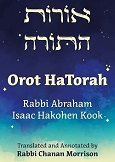
“At every available opportunity,” Rabbi Ze'ev Gold wrote,“ I tell the story of the remarkable lesson I had the privilege to learn from our great teacher, the gaon and saintly Rav Kook, may the memory of the righteous be a blessing.”
Rabbi Gold (1889-1956), a prominent figure in the religious-Zionist Mizrahi movement, once accompanied the Chief Rabbi to the community of Magdiel1 in the Sharon area. The rabbis were invited to plant saplings in an official ceremony to inaugurate a new forest.
As Rav Kook was handed a sapling to plant, Rabbi Gold was astounded to see the rabbi’s reaction. Rav Kook’s face radiated like a burning torch, and his entire body quivered with excitement. He did not use the hoe he had been provided, but knelt down to the soil and dug a hole in the earth with his bare hands. Hands shaking, he reverently placed the sapling in the ground, while murmuring his gratitude to God for the privilege of planting a tree in the Holy Land.
On the trip back to Jerusalem, Rabbi Gold turned to the Chief Rabbi. “Why did you exhibit such deep emotions when you planted a tree into the ground? Nowadays, thank God, hundreds of trees are planted every day in the Land of Israel!”
“As I held that young sapling in my hands,” Rav Kook replied, “I recalled how the Sages elucidated the verse, “Follow the Eternal your God... and cling to Him” (Deut. 13:5). They asked:
Is it possible for flesh and blood to ascend to the heavens and cling to the Shechinah, about Whom it is written, “For the Eternal your God is a consuming fire” (Deut. 4:24)?
Rather, understand the verse as follows: At the beginning of creation, the Holy One engaged in planting, as it says, “God planted a garden in Eden” (Gen. 2:8). Similarly, when you enter in the Land of Israel, you should first engage in planting, as it is written, “When you will come into the Land, you shall plant all types of fruit trees” (Lev. 19:23). (Vayikra Rabbah 25:3)
“When I grasped that tender sapling in my hands and prepared to plant it in the holy earth,” Rav Kook continued, “I contemplated these words of the Sages. I felt as if, at that very moment, I was clinging to the Shechinah, and I was overwhelmed with feelings of awe and reverence!”
(Stories from the Land of Israel. Adapted from Zehav HaAretz by Rabbi Ze'ev Gold (1982); Mo'adei HaRe’iyah, pp. 222-223.)
1 The town of Magdiel was founded in 1924. Rav Kook objected to the name Magdiel, as this was the name of an Edomite chieftain (Gen. 36:43). Even worse, ancient Jewish tradition identifies Magdiel as Rome, the nation that conquered the Land of Israel and destroyed the Second Temple (see Rashi ad loc, referencing Pirkei d'Rabbi Eliezer). This did not, however, deter Rav Kook from participation in the tree-planting ceremony in the town.
There were rumors that Rav Kook had foreseen that the name Magdiel would not endure. And in fact, in 1964, the town of Magdiel was combined with its neighboring towns, and the new municipality was renamed “Hod Hasharon.”
Rabbi Tzvi Yehudah Kook related that, shortly after this event, he received a letter from a resident of Netanya. For many years, the author of the letter had studied his father’s books, which he found very inspiring. But when he heard a rumor that Rav Kook predicted the neighboring town of Magdiel would “be erased from the map,” he found this so disturbing that he stopped studying the rabbi’s writings.
Following the 1964 municipality change, the Netanya resident offered his apologies. He now understood how Rav Kook’s prediction was fulfilled, as only the name Magdiel was erased from the map, with Hod Hasharon taking its place. He expressed his sincere regrets, promising to resume studying the Rav’s writings.





